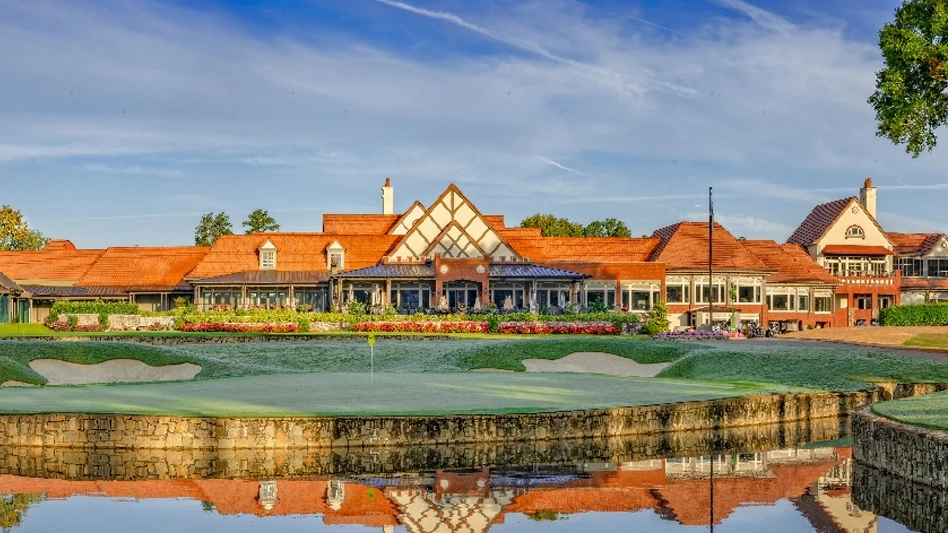
Bobby Jones played Knollwood Country Club and golf lore indicates he met Clifford Roberts in the club’s grill. Golden Age architects A.W. Tillinghast, Seth Raynor and Charles Banks also occupy spots in Knollwood history. After extensive research, current architect Ian Andrew concluded each member of the triumvirate should be credited with designing the Westchester County, New York, course.
A holistic understanding of club history inspired superintendent Matt Neus last fall when the club embarked on cramming significant restoration work into one offseason. The golf course at Knollwood, a club with a history extending to the 1890s, reopened earlier this year with fewer trees, better bunkers, expanded greens and 1920s panache.
In the case of Knollwood, a restoration meant delving deep into a fascinating and complex architectural history. “If you’re weren’t excited about this, then you don’t really care about golf history,” Neus says. “That’s to be 100 percent honest. There was a ton of excitement about everything.”
The restoration process started with the club hiring Andrew in the spring of 2010 to develop a master plan. Before clearing trees and expanding greens, Andrew needed to determine the influence each architect had on the course. Knollwood’s original course, which was designed by civil engineer Lawrence Van Etten and opened in 1895, measured 5,300 yards in 1924, a distance unsuitable for any private club of the era, especially one surrounded by elite classic courses.
Harry Kelly Jr. acquired land owned by deceased member Henry Evans. Kelly then arranged the sale of the land to the club, giving the club space to expand the course. Tillinghast visited Knollwood multiple times in the first half of 1925 before the club decided to discontinue his services and retain Raynor as the architect. Raynor died in 1926, leaving his associate Banks to oversee the completion of the project.
Banks, according to Andrew, designed enough of the course to be listed alongside Tillinghast and Raynor as a designer of record. Combining his research with a drawing hanging in the clubhouse and 1930s aerials, Andrew accumulated the necessary information to devise a master plan that would reintroduce the work of Raynor and Banks to the membership.
Master plans created in the middle of the Great Recession often led to delayed restoration. The club restored the 16th green in 2011 and third green in 2012 before intense work stalled. Tree management became an immediate focus when work resumed. Agronomic considerations spurred the early part of the process. “The rule of thumb is that if it’s a sunlight problem, it goes,” Andrew says. “I always believed that to be your starting point.”

Oak and pine trees are Knollwood staples, but the course also included clusters of hickory, maple and walnut trees. Parts of Knollwood Neus was responsible for maintaining when he became superintendent in 2013 would have been unfamiliar to Tillinghast, Banks and Raynor.
Turf health and views improved gradually, and Andrew says members began embracing tree removal when clearing a section of white pines behind the 16th hole flipped a problem green into a playable surface. Clearing trees and establishing fescue, yet keeping a few towering oaks, behind the eighth green opened views of multiple holes and fostered further trust between the restoration team and membership.
“There were a few members who thought it was sacrilegious to take out a tree,” club president Nick Greto says. “We treated it like a Band-Aid. We were going to do what we had to do, and we just did it. I have members who were opposed to it and they are now like, ‘I don’t even remember those trees.’ Now that they are gone, it looks right. The health of the course is so much better.”
Andrew says tree removal often “snowballs” once members see the results. And even after an extensive restoration, tree removal remains a frequently discussed topic at a private club.
“We still have a couple of areas and some greens that have too much shade,” Greto says. “We are trying to figure out ways to get more light on them. It’s funny. I had a few people who were like, ‘I don’t want to take anymore down.’ And then I had a few people who were like, ‘Take them all down. We love it.’ We try to keep a balance. We are not a links course. There’s still a lot of trees on our golf course. We took them down as far as having the impact of getting the grass to grow where you wanted it to grow.”

Initially, Knollwood members approved executing the bulk of the work during a two-year stretch beginning last fall. But, after further exploring options and costs, club leaders concocted a plan that would condense the work into one fall. Members approved the expedited timetable, and favorable weather allowed a team from GCBAA member NMP Golf Construction and Neus’s crew to finish major elements of the project by the end of 2016. Neus adopted a “what can we do to help” approach to construction. For example, his team stripped sod from the 12th green and returned it to the surface after the NMP crew rebuilt the green.
Like most post-recession projects, bunkers represented a key part of Knollwood’s restoration. Bunkers had not only become hazards to scorecards, their condition threatened polished club heads. Knollwood joined the USGA in the 1890s, but it didn’t follow every golf rule in 2016. Poor construction and contamination led to a local rule permitting members to lift rocks from bunkers. As little as one inch of rain, Neus says, would require two days of bunker repairs.
Subsurface rock forced Andrew to devise crafty ways to ensure bunkers drained and diverted water properly. The restoration left Knollwood with flat-bottomed, grass-faced bunkers, increasing the amount of maintenance around the hazards but easing the burden on Neus’s crew when following significant rain.
Improved bunkers bring expanded expectations, and Neus experimented with multiple rakes until finding one that satisfied members. The crew now carries rakes with similarities to the ones members use to smooth footprints. Neus spent more hours in 2017 training employees on fly mowing and raking techniques than previous seasons.
“It took some time, but we are just about at the point where everybody seems to be happy with the maintenance of the bunkers, how we rake the bunkers and how they play out of the bunkers,” Neus says. “It wasn’t just a learning curve for us, but it was a learning curve for the membership as well.”

Knollwood represents the third major project Neus has experienced in his career. He worked at Wilmington (Del.) Country Club when Keith Foster renovated the Robert Trent Jones Sr.-designed course and served as an assistant superintendent when Mike DeVries started work at Donald Ross-designed Siwanoy (N.Y.) Country Club.
“It’s been pretty amazing for me when you get to be out there and say, ‘I’m literally maintaining and playing the same golf course that Bobby Jones once played,’” Neus says. “This course has not changed much. Obviously, with agronomic practices ... speeds have gotten faster and so on and so forth. But as far as the actual intent of the golf course, everything is intact and not many people get to say that. It’s a really, really cool experience and it’s something that I don’t take lightly. Everybody should be very proud of this golf course and this property because it is something special.”
Working with a superintendent who embraced the historical aspect of the project enthused Andrew, who relishes restoring the work of Golden Age architects. Knollwood offered the Ontario-based architect his first crack at working on a course Raynor helped design.
By showcasing its past, club officials are protecting Knollwood’s future. Andrew says a well-executed restoration can help a club remain viable in a competitive market such as Westchester County, home to Winged Foot, Quaker Ridge, Sleepy Hollow and numerous other celebrated courses. Knollwood spent $1.1 million on the project, which also involved altering target lines and moving two bunkers on the fourth hole. One green that didn’t change much was the ninth, a Van Etten-designed complex Tillinghast, Raynor and Banks left in its original spot.
“Over the next four or five years, I think we are going to gain more members with the work we have done because we are reinvesting in the golf course,” Greto says. “It’s not something that you can stop doing because all the other courses are constantly trying to improve themselves. When you stop trying to improve yourself, that’s when things get stale. It’s a competitive area. It’s rich in golf courses. There are some fantastic golf courses within a 10-, 15-mile radius. It’s unbelievable. You have to do these things.”
Guy Cipriano is GCI’s senior editor.
Explore the November 2017 Issue
Check out more from this issue and find your next story to read.
Latest from Golf Course Industry
- Tartan Talks 105: Nathan Crace and Todd Quitno
- Disease Discussion 24: Let the turf talk to you
- From the publisher’s pen: Foggy intrigue
- USGA releases Water Conservation Playbook
- Vilamoura Golf courses awarded GEO Certified status
- GCSAA’s Health in Action 5K/2K reaches fundraising goal
- Landscapes Golf Management to participate in data analyzation initiative
- Reel Turf Techs: Carl Michael





